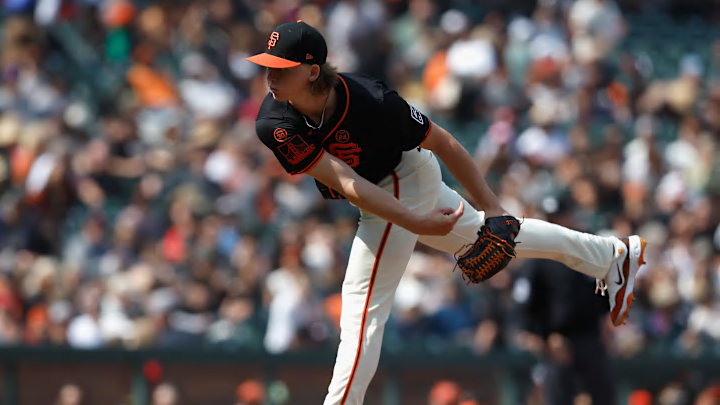SF Giants rookie pitcher Hayden Birdsong arguably reached the majors sooner than expected. Now that he is here, it would behoove the Giants to get a long look at the 22-year-old pitcher in the final 10 weeks of the season.
Why the SF Giants should be motivated to get a long look at a rookie starter
Birdsong began the year in Double-A. It was his second stint in the Eastern League as he pitched to a 5.48 ERA in eight outings down the stretch in 2023. He quickly proved that he was above the competition as he posted a 2.05 ERA in 11 starts with the Richmond Flying Squirrels this year before earning a promotion to Triple-A.
The Giants added Birdsong to the major league roster after just two starts with the Sacramento River Cats. Climbing the minor league ladder is a process and it feels like the Giants bypassed that to some extent with how quickly they called up Birdsong. That said, 21 starts in the upper minors is not unusually aggressive with how teams promote prospects in 2024. It is quick, but not necessarily an exception.
The Giants had a need for pitching as the bullpen had been used extensively while the rotation weathered through a handful of injuries. Sometimes, circumstances thrust players to arrive sooner than expected. Plus, it was a sign of how the Giants view Birdsong, who was beginning to get recognized on top-100 prospect lists.
Since then, the right-handed pitcher has tallied a 3.78 ERA with 18 strikeouts against 10 walks in four starts. It is hard to grasp too much in just four starts and Birdsong is not a finished product yet, especially in terms of control. He has shown three, above-average pitches with a high 90's fastball, slider, and a curveball. He mixes in an occasional changeup as well.
At the very least, Birdsong has the type of arsenal to be successful in the majors. How his control develops will be what influences his ceiling.
Regardless, the Giants need to find out if Birdsong can plug a rotation hole as soon as next season. Kyle Harrison entered this season in a similar position. He was light on major league experience, but likely did not have anything else to prove in Triple-A. The lefty pitcher has posted a 3.86 ERA in 17 starts this year and has answered the question of whether he can hold down a rotation spot for the foreseeable future.
There will still be some growing pains as he learns to trust his three-pitch mix consisting of a low-to-mid 90's four-seam fastball with a changeup and slurve. The Giants need to accept the growing pains with Birdsong as well down the stretch.
As the club begins to sketch out the 2025 rotation, you can confidently pencil in both Logan Webb and Harrison. Both Blake Snell and Robbie Ray have player options to consider, so it is tough to know what direction they will go at this point. Alex Cobb is a free agent.
Of course, Jordan Hicks is under contract for three more seasons and can be seen as a wild card who can move in and out of the rotation as the need arises. I think Hicks has proven that he can be an effective starting pitcher, but questions about his workload will persist.
This is where Birdsong comes into play. If the Giants can confidently plug him in with Webb and Harrison, it minimizes the need for the rest of the rotation. Perhaps, one of Ray or Snell declines to exercise their respective player option, meaning that they remain with the club. That now gives them four starters with Hicks serving as either a potential No. 5 option or a late-innings reliever.
There is a financial motive to this as well. Both Harrison and Birdsong would be under pre-arbitration contracts in 2024. Even adding a back-end rotation arm likely costs about $10 million annually, but being able to plug two rotation spots on rookie contracts allows the club to pursue upgrades elsewhere.
There is enough fungibility with the rotation this year to allow Birdsong to continue getting starts in the second half even when Robbie Ray and Alex Cobb return. The Giants would be smart to get as large of a sample as possible in evaluating the rookie pitcher before the season ends.
